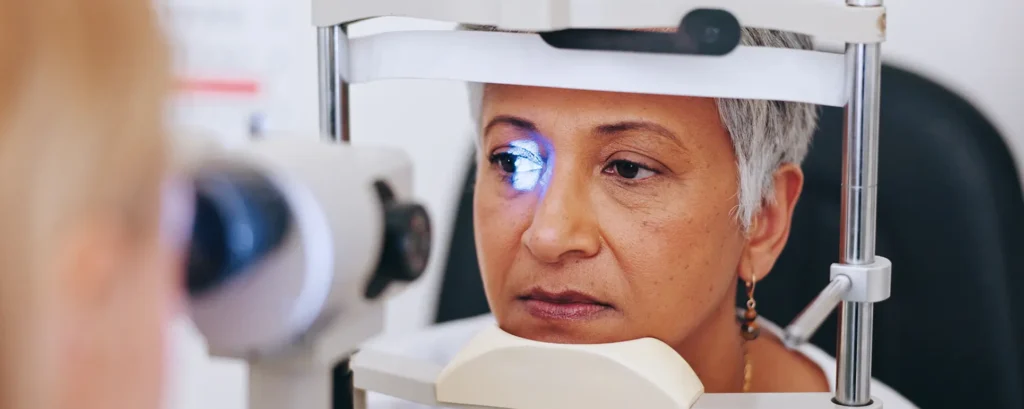If you’ve had cataract surgery, chances are you enjoyed clearer vision for some time afterwards. But like many patients, you may later notice your sight starting to blur again. This often isn’t a cataract returning, but something called posterior capsule opacification (PCO). To fix it, eye specialists commonly recommend a quick outpatient laser procedure called a YAG capsulotomy. While this treatment is safe and highly effective, some people notice floaters in their vision afterwards. These floaters can range from tiny specks to more noticeable shapes drifting across your field of view.
In this article, we’re going to walk through exactly why floaters sometimes appear after YAG laser treatment, what they mean, and what you can expect going forward. You’ll also learn when it’s perfectly normal to ignore them and when you should get in touch with your eye clinic for a check-up.
What Is a YAG Capsulotomy?
A YAG capsulotomy is a quick laser treatment used to restore vision when the lens capsule—the thin membrane that holds your artificial intraocular lens (IOL) in place—becomes cloudy. After cataract surgery, it’s normal for the capsule to gradually thicken or wrinkle. This creates a hazy layer that scatters light, leading to blurred or misty vision, glare, or difficulty reading.
During the YAG procedure, your eye specialist uses a Nd:YAG (neodymium-doped yttrium aluminium garnet) laser to make a tiny opening in the capsule. This clears the path for light to reach the retina without obstruction. The treatment itself usually takes only a few minutes, requires no cuts or stitches, and recovery is swift. Most people notice an immediate improvement in clarity.
But as with any eye procedure, there can be temporary side effects. Floaters are one of the most common, and while they’re usually harmless, they can feel concerning if you don’t know what’s happening.
Why Do Floaters Appear After YAG Capsulotomy?
Floaters are small clumps or strands that drift within the vitreous, the clear jelly-like substance filling the eye. After YAG treatment, floaters can appear for several reasons.
First, the laser energy used to open the capsule can create tiny fragments of capsule material or microscopic bubbles. These fragments can then drift into the line of sight, where you see them as floaters. In most cases, they dissolve or move out of the way within days to weeks.
Second, the procedure may stir up debris that was already present in the vitreous. Sometimes patients already have floaters before the laser, but they notice them more once their vision suddenly becomes clearer. The improved light transmission makes pre-existing floaters more obvious.
Third, in rare cases, floaters may signal a more serious issue such as a posterior vitreous detachment (PVD) or even a retinal tear. This is why your surgeon will warn you to report sudden flashes of light, a shower of floaters, or a shadow across your vision immediately.
How Long Do Floaters Last After YAG Laser Treatment?

For most patients, new floaters after YAG capsulotomy are short-lived. They may be noticeable for a few days, sometimes up to a few weeks, but tend to settle as the eye heals and debris moves away from the central line of sight.
In fact, many patients find that their brain quickly learns to ignore floaters, especially if they remain small and stable. Floaters that do persist are often less distracting over time, even if they don’t vanish completely.
However, if floaters appear suddenly in large numbers, grow worse instead of better, or are accompanied by flashing lights or loss of vision, you should get checked urgently. These could be warning signs of a retinal problem that needs immediate attention.
Are Floaters After YAG Capsulotomy Dangerous?
The reassuring news is that in most cases, floaters after YAG capsulotomy are not dangerous. They’re simply a side effect of capsule fragments or vitreous debris, and they fade with time.
That said, your eye specialist will always caution you about the small risk of retinal complications. YAG treatment slightly increases the lifetime risk of retinal detachment compared to eyes that haven’t had the procedure. While still rare, this makes it essential to stay alert to any dramatic change in floaters or the sudden onset of flashing lights.
So, while the appearance of a few floaters is usually harmless, your awareness and quick response to warning signs are key to protecting your vision.
What to Expect in the First Few Days After Treatment
Immediately after your YAG capsulotomy, you may notice:
- A sudden improvement in clarity. Colours appear brighter and vision sharper within hours.
- A few floaters drifting across your vision. These often appear as dots, squiggles, or translucent blobs.
- Mild light sensitivity. Sunglasses can help for the first day or two.
- Slight eye ache or irritation. This usually resolves quickly.
Your clinic will normally check your eye pressure about an hour after the procedure, as a temporary spike can occur. You’ll also be given a follow-up appointment to ensure the capsule opening is clear and healing well. Floaters noticed at this stage are nearly always temporary and expected.
When Should You Contact Your Eye Specialist?

It’s important to know the red-flag signs that mean you should call your clinic without delay:
- A sudden shower of new floaters, especially if accompanied by flashing lights.
- A dark curtain or shadow creeping across your vision.
- Severe eye pain or sudden loss of vision.
These symptoms can indicate a retinal tear or detachment, which is a medical emergency. Prompt laser treatment or surgery can save your sight, but only if dealt with quickly. Even if you’re not sure, it’s always better to check.
Do Floaters Always Mean Something Is Wrong?
Not necessarily. In fact, most floaters after YAG treatment are completely benign. The vast majority of patients experience them to some degree, and for many they’re a short-term nuisance rather than a long-term problem.
It’s worth remembering that floaters are extremely common as we age, even without laser treatment. Many people in their 50s, 60s, and beyond naturally develop floaters as the vitreous shrinks and pulls away from the retina. YAG capsulotomy doesn’t cause this process, but it can make you notice floaters more clearly.
Coping With Floaters If They Persist
If your floaters remain long after YAG treatment, there are several ways to cope with them. For most people, simple reassurance and adaptation are enough. Your brain learns to tune out the floaters over time, and they become less noticeable in daily life.
In very rare cases where floaters are large, dense, and severely affecting quality of life, procedures like vitrectomy or laser vitreolysis may be considered. These are not routine, as they carry risks, but they are options for selected patients. Most people, however, don’t need further intervention.
Looking Ahead After YAG Capsulotomy
Once your capsule is opened with the YAG laser, the results are permanent. Unlike cataracts, posterior capsule opacification cannot grow back once treated. This means you should continue to enjoy clear vision long-term.
Floaters, if they appear, are almost always a temporary side note in an otherwise highly successful procedure. The key is to stay informed, know the warning signs, and attend your follow-up appointments.
FAQ Section
1. Are floaters after YAG capsulotomy normal?
Yes, it’s very common to notice floaters after a YAG capsulotomy. These usually come from tiny fragments of the capsule or bubbles created during the laser procedure. They may also be existing floaters that become more noticeable once your vision clears. While they can feel distracting at first, they’re generally harmless and tend to improve as the eye heals and the brain adjusts to ignoring them.
2. How long will floaters last after YAG treatment?
Most floaters settle down within a few weeks, but the exact time varies between individuals. For some, they disappear completely, while for others they fade into the background but don’t vanish entirely. What’s important is whether they remain stable or suddenly increase. If you notice a sudden burst of new floaters or they’re accompanied by flashing lights, it’s essential to contact your eye specialist to rule out anything more serious.
3. Can YAG capsulotomy cause retinal detachment?
There is a small increase in the lifetime risk of retinal detachment after YAG capsulotomy, but this complication is still rare. The laser itself doesn’t directly cause a detachment, but the procedure can trigger changes in the vitreous gel that sometimes place extra traction on the retina. This is why you’re advised to seek urgent help if you notice flashing lights, a sudden shower of floaters, or a curtain-like shadow over your vision. Acting quickly makes a big difference to the outcome.
4. Why do I see more floaters after my vision improved?
One reason you may notice more floaters is simply because your vision is clearer after the YAG laser. Before treatment, the cloudy capsule blurred everything, which could have made floaters less obvious. Once the capsule is opened, light passes through more effectively, and floaters that were already present become more visible. It doesn’t necessarily mean new floaters have formed — it may just be that you’re now able to see them more clearly.
5. Do floaters damage the eye?
Floaters themselves don’t cause any damage to the eye. They are simply shadows cast by clumps of collagen or debris within the vitreous gel. Most people adapt to them over time, and they become less distracting as the brain learns to filter them out. The main concern is not the floaters themselves, but the possibility of them being linked to more serious retinal problems — which is why monitoring sudden changes is so important.
6. Should I be worried if I only see one or two floaters?
No, one or two floaters on their own are not usually a cause for concern. Almost everyone develops a few floaters naturally with age, and a small number often appear after YAG capsulotomy. They’re usually temporary and don’t interfere much with vision. The key thing is to be aware of any sudden increase in their number or changes in your vision that occur alongside them, as that’s when you should seek professional advice.
7. Can anything be done to remove floaters?
In most cases, treatment for floaters isn’t necessary because the symptoms improve with time and adaptation. If floaters are persistent and severely impact daily activities, options like vitrectomy surgery or laser vitreolysis can be considered. However, these are only offered in rare cases because the risks of such procedures can outweigh the benefits. For the majority of people, reassurance and adjustment are the safest and most effective approaches.
8. Will floaters get worse with time?
Floaters don’t always get worse over time — in fact, for many people, they become less noticeable. This is partly because the floaters drift away from the centre of vision and partly because the brain adapts by filtering them out. That said, if you ever experience a sudden worsening of floaters, especially with flashing lights or loss of vision, it could point to a retinal issue that requires urgent attention. So while floaters are often stable, new changes should never be ignored.
9. Is YAG capsulotomy safe overall?
Yes, YAG capsulotomy is considered a very safe and routine procedure worldwide. It’s performed in a clinic setting without the need for cuts, stitches, or general anaesthetic. Complications are rare, and the vast majority of patients experience clearer, brighter vision afterwards. Floaters are one of the most common temporary side effects, but for most people, they are a minor and short-lived issue compared to the benefits of improved vision.
10. What should I do if I’m unsure about my floaters?
If you’re ever uncertain about floaters after YAG capsulotomy, the best approach is to get in touch with your eye clinic. Even if it turns out to be nothing, getting checked provides reassurance and ensures that anything serious is picked up early. Ophthalmologists would much rather you raise concerns than risk a problem being missed. Trust your instincts — if something feels unusual or worrying about your floaters, it’s always worth having your eyes examined.
Final Thoughts
Floaters after YAG capsulotomy are a common experience and, in most cases, nothing to worry about. They usually represent harmless debris and tend to fade or become less noticeable with time. Still, it’s important to know when floaters are just a mild inconvenience and when they may signal something more serious like a retinal tear. By staying aware, attending your follow-ups, and acting quickly if red-flag symptoms appear, you’ll be well placed to protect your sight.
If you’d like to learn more about cataract treatment and YAG laser procedures, you can visit the London Cataract Centre, where you’ll find further information and support tailored to your needs.
- American Academy of Ophthalmology (2024) What is a posterior capsulotomy? American Academy of Ophthalmology. Available at: https://www.aao.org/eye-health/treatments/what-is-posterior-capsulotomy (Accessed 26 August 2025).
- Cleveland Clinic (2024) YAG laser capsulotomy (posterior capsulotomy). Cleveland Clinic. Available at: https://my.clevelandclinic.org/health/procedures/yag-laser-capsulotomy-posterior-capsulotomy (Accessed 26 August 2025).
- Elbaz, U., Hakkala, L., Hecht, I., Achiron, A., Gershoni, A. and Tuuminen, R. (2021) Nd:YAG capsulotomy is not a risk factor for retinal detachment after phacoemulsification cataract surgery. Acta Ophthalmologica, 99(7), e1018–e1026. Available at: https://pubmed.ncbi.nlm.nih.gov/33423371/ (Accessed 26 August 2025).
- Liu, H., Liu, X., Chen, Y., Wang, D., Li, Y., Chen, H. and Ma, X. (2022) Effect of Nd:YAG laser capsulotomy on the risk for retinal detachment after cataract surgery: systematic review and meta-analysis. Journal of Cataract and Refractive Surgery, 48(2), 238–244. Available at: https://pubmed.ncbi.nlm.nih.gov/34538778/ (Accessed 26 August 2025).
- Kingston and Richmond NHS Foundation Trust (2024) Posterior capsular opacification (PCO) and YAG laser capsulotomy. Available at: https://www.kingstonandrichmond.nhs.uk/patients-and-families/patient-leaflets/posterior-capsular-opacification-pco-and-yag-laser-capsulotomy (Accessed 26 August 2025).

